| Please access the following URL if you want to secure using SSL. All pages in the site will be secure pages. |
https://secure02.blue.shared-server.net/www.fish-food.co.jp/message english 9.2024.html |
Welcome to FISH FOOD TIMES
Sep. 2024 issue No.249


Scalpel sawtail "New ver."
It's reasonably priced, but...
In late August, when I went to the fish section that I always visit, I found a scalpel sawtail on display in the bulk sales section. Since I was offered a very low price, I decided to make this scalpel sawtail the theme for the September issue and bought one.
According to a release from the Izu Branch of the Shizuoka Prefectural Fisheries Technology Research Institute, a fish called scalpel sawtail is caught in large numbers in fixed nets in August and September. The following image from the document shows a 3.9-ton scalpel sawtail landed at the Ito Fish Market in Shizuoka Prefecture in August 2021, which was landed in one day at a single fishing ground.

Mass entrapment of scalpel sawtails in this manner occurs almost every year for just one or a few days, and tends to occur mainly from summer to autumn. The Shizuoka Prefectural Fisheries Technology Research Institute Izu Branch analyzed the fishing characteristics of scalpel sawtails based on monthly catches and fishing ground catches from 1987 to 2021 in large fixed nets on the east coast of Izu, Shizuoka Prefecture. As a result, it was found that the monthly catches of scalpel sawtails (average values from 1987 to 2020) were particularly high in August and September, and low in other months, as shown in the graph below.
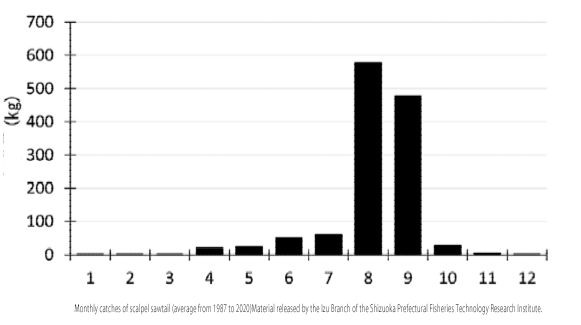
Since the scalpel sawtail's spawning season is known to be in the spring, it is unlikely that they would have gathered in large schools in shallow waters to spawn, and it is not yet clear what causes this phenomenon.
FISH FOOD TIMES had an article about scalpel sawtail in No. 65 Scalpel Sawtail Hiratsukuri Sashimi (May 2009 issue), so this will be the second time it has been featured as a target fish species in this month's issue. As usual, the author struggled to choose a fish species to feature this month, but the article on scalpel sawtail written 15 years ago was too simple and not very substantial, and it was one of the fish that the author had reflected on and wanted to revisit in more depth.
In general, scalpel sawtails are unpopular, being considered a rather unpalatable fish, and their trading price in fish markets is low. Since fish can be purchased at a low price, the selling price is naturally lower, but customers tend not to pay attention to fish at fish counters. For this reason, fish section staff generally do not actively purchase scalpel sawtails, and you should assume that you will rarely see them on display in the fish section.
Scalpel sawtails in the sea are not targeted by anglers as well as fishermen, and even if they are caught, they are released, so they are abundant on the coast and reef areas, and their population is stable. The numbers seem to be maintained. The scalpel sawtail, which thrives in abundance due to the lack of fishing pressure, is considered one of the fish that poses a troublesome problem to fisheries, as it eats a lot of seaweed, which is its staple food.
This problem is known as "marine isoyake." This is the phenomenon in which seaweed stops growing on the ocean floor and is also known as "marine desertification." Generally, the word isoyake is used to describe a phenomenon in which the catch of spiny lobsters, abalone, and other species that depend on seaweed beds to survive is significantly reduced due to the withering or decline of seaweed beds. A seaweed bed is a forest-like or grassland-like community of seaweed and seaweed, and it is also a spawning and habitat place for fish and shellfish, and is an important infrastructure that supports coastal fisheries.
One of the causes of isoyake in the ocean is the explosive increase in herbivorous fish species. The scalpel sawtail is one type of herbivorous fish, but it is not just the scalpel sawtail; other herbivorous fish species such as brassy chub, rabbitfish, and parrotfish feed in groups on seaweed beds, which is also a cause of the accelerating isoyake. However, their value is hardly evaluated in the fish market, and because they are not traded as a commodity, they are not targeted by fishermen, and they are becoming more and more powerful in the ocean.
Specific facts about eating herbivorous fish species
What these herbivorous fish species have in common is that they have a "unique smell." This smell is what makes fish such as the scalpel sawtail disliked, so if we could find a way to overcome the smell and make them tasty to eat, the value of herbivorous fish species would increase and they would be circulated in large numbers, which would lead to a decrease in the number of isoyake in the ocean.
As an example of countermeasures, Kura Sushi, a national conveyor belt sushi chain, sells ``cabbage scalpel sawtail'', which is cultivated by feeding scalpel sawtail cabbage that would otherwise be discarded.
The text in parentheses below is Kura Sushi's press release.
"Inspired by what our staff saw on television about 'sea urchin farming on cabbage,' we conducted a demonstration experiment using cabbage as food and found that this reduced the scalpel sawtail's smell. As we were able to create a product that allows you to enjoy the high-quality fat and meat quality that scalpel sawtail naturally has, we test-sold it at 10 stores in November 2020 and it was well received. In response to this, we have now put in place a supply system to make nationwide sales for the first time. This time, scalpel sawtail caught in fixed nets in the Kyushu region will be farmed by feeding them cabbage that would have been discarded, and we plan to sell approximately 140,000 servings."
Kura Sushi has completed trial sales of Cabbage Scalpel Sawtail and is planning to sell it nationwide from November 2022, but on the other hand, no countermeasures like Kura Sushi will be taken at the fish retail site. Instead, it remains the same.
As FISH FOOD TIMES, I would like to supplement what I were unable to fully express in No. 65 scalpel sawtail hiratsukuri sashimi (May 2009 issue), and although I cannot do something as grand as Kura Sushi, I thought I might offer some tips that might be of some help to those working in the fish retail industry in selling scalpel sawtail. Therefore, I would like to describe below some delicious ways to eat scalpel sawtail that we attempted.
Cooking work of scalpel sawtail
This is the 1.3kg scalpel sawtail I got this time.
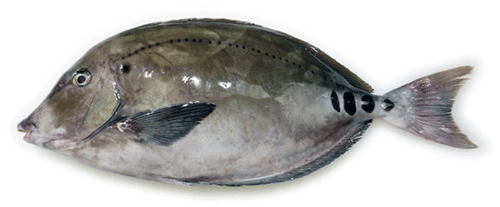
The fish was processed as follows to remove fish blood, and was of good freshness.
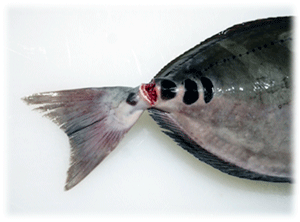
When a scalpel sawtail eats seaweed, it stores it in its stomach for a while and ferments it, and during that time-consuming fermentation process, the odor of the stomach internal organs transfers to its body, which is a kind of It seems to be the origin of the unique smell.
The following cooking process is a method that is conscious of removing the odor-causing internal organs in their original form without damaging them as much as possible.
| Scalpel sawtail internal organs removal work | |
|---|---|
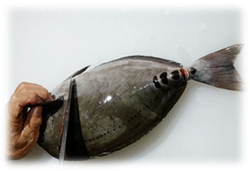 |
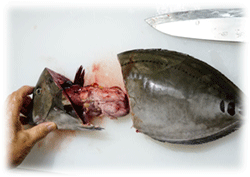 |
| 1,Make a cut next to the gills lid on the lower body side and cut it open to the back of the pelvic fin. | 5,Once the internal organs have been pulled out to a certain extent, the head and internal organs are separated from the body while still connected. |
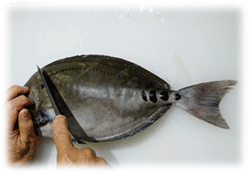 |
 |
| 2,Make an incision next to the gills lid on the upper body and cut open up to behind the pelvic fin. | 6,Make an incision in the chiai meat inside the abdominal cavity with the tip of a deba knife. |
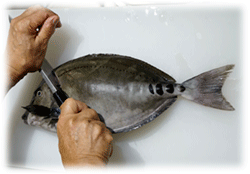 |
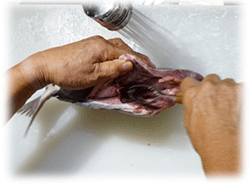 |
| 3,Separate the hard backbone that connects the head and body using the base of the Deba knife. | 7,Remove the blood and the remaining parts of the internal organs using a sasala or a spoon. |
 |
 |
| 4,With the head still attached, insert your fingers into the abdominal cavity and grab and pull out the organs, being careful not to crush them. | 8,The state after the internal organs have been completely removed without leaving anything behind. |
After removing the head and internal organs of the scalpel sawtail, the internal organs were solid and solid like a lump of fat. The internal organs were not in a state where they had lost their shape and were flowing, as is common with red meat fish from the blue-colored family. For a flat fish, the body was plump and thick, just like a fish that was about to spawn and had stored up a lot of fat and was in season.The spawning season for scalpel sawtails is in the spring, which means that their peak season is from winter to spring, but as mentioned above, when you consider the fact that scalpel sawtails are mainly caught in August and September, it is tempting to think that their peak season might be summer.
After cutting off the head and removing the internal organs, the plump scalpel sawtail looked so good that it couldn't possibly be a bad fish. I disassembled the fat scalpel sawtail in three pieces, but because the body was flat, I used the one side disassembling method as shown below.
| one side disassembling work process of scalpel sawtail | |
|---|---|
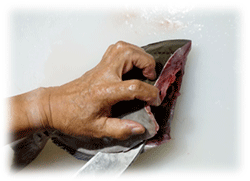 |
 |
| 1,Make an incision along the anal fin on the lower body toward the backbone. | 5,Instead of cutting the belly bones by pulling the tip of the knife, press the tip of the blade down to separate them. |
 |
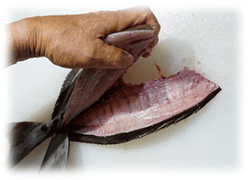 |
| 2,Don't stop cutting before the backbone, but continue cutting past the backbone toward the dorsal fin. | 6,Once you have cut away the belly bone, continue cutting past the backbone towards the edge of the anal fin. |
 |
 |
| 3,Cut open the edge of the dorsal fin from the head side to the tail fin side and separate the lower body. | 7,Cut open the anal fin from the head side to the tail fin side and separate the upper body. |
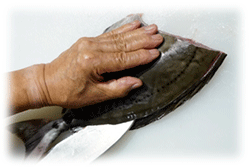 |
 |
| 4,Cut along the dorsal fin on the upper body towards the backbone. | 8,Even if you handle it roughly there is no risk of the meat breaking, and you can disassemble the three pieces. |
When I tried disassembling the three pieces, it also had a solid structure, and there was no fear of it breaking meat even if I handled it a little roughly. For example, sea bass has a flesh that is completely opposite to a fish that will break meat immediately no matter how carefully you handle it.
Having disassembled the scalpel sawtail into three pieces, I decided to prepare it for use in four different dishes: sashimi, sushi, deep-fried, and fried fish. The FISH FOOD TIMES article from 15 years ago only featured hiratsukuri sashimi, but I pondered how to differentiate this time from the previous article, and came up with a dish that would make use of the scalpel sawtail's tough skin. I thought that searing would be a good way to make the most of the fish skin, so I decided to add that step, but I did not remove any of the tiny scales from the scalpel sawtail, and instead worked towards creating a dish that would be eaten with the scales as well.
1,First of all, cooking the upper body
| The process of dividing the upper body into two parts, creating the skin-pulling part and the searing part. | |
|---|---|
 |
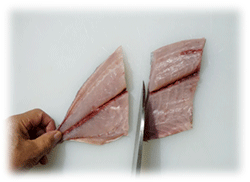 |
| 1,Using the tip of a deba knife, make an incision under the belly bone on the upper side of the body. | 6,Divide into two parts: head side and tail side. |
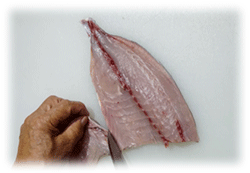 |
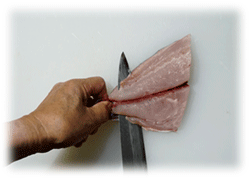 |
| 2,Cut under the belly bone all the way to the end, and then trim it at the end. | 7,Make an incision on the skin at the tail end. |
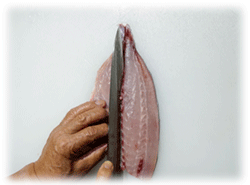 |
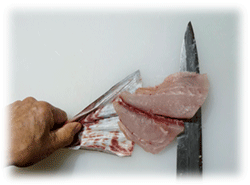 |
| 3,The chiai bone is very difficult to remove, so switch to a yanagiba knife and make a shallow incision on the left side of the chiai bone. | 8,The skin is removed using the outside pulling method. There is a hard bony plate at the narrow end of the tail, so the tip of the yanagi blade must be slightly raised. |
 |
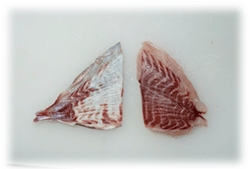 |
| 4,Similarly, make a shallow incision on the right side of the chiai bone. | 9,The skin from the tail side has been removed. |
 |
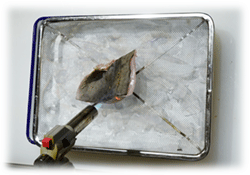 |
| 5,Pull out all the chiai bones using a bone removal tool. | 10,Sear the skin of the remaining part on the head side, which has been divided into two parts, firmly. |
2,Cooking the lower body
| The process of searing the skin of the lower body and dividing it into two parts. | |
|---|---|
 |
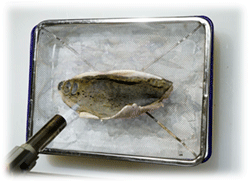 |
| 1,Using the tip of a deba knife, make an incision under the belly bone on the lower side of the body. | 5,Take a slightly longer time and sear the skin thoroughly. |
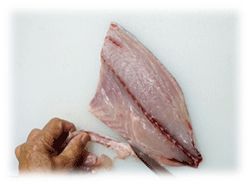 |
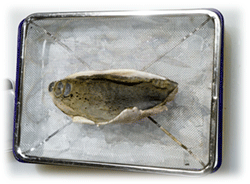 |
| 2,Cut under the belly bone all the way to the end, and then trim it at the end. | 6,After the skin has been seared, the flesh is cooled so that the skin and flesh can blend together. |
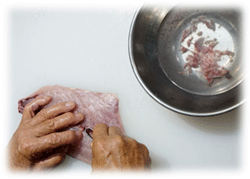 |
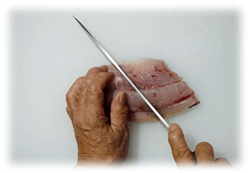 |
| 3,The chiai bone is pulled out using a boning tool, and like the upper body, cuts are made on both sides of the chiai bone to make it easier to pull out the bone. | 7,When dividing it into two, cut carefully so that the seared skin does not shift and peel off. |
 |
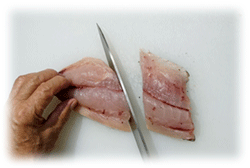 |
| 4,Lay out crushed ice, cover with a net, and place the meat with the skin on top. | 8,Without moving the tip of the knife back and forth significantly, cut it in half by pushing it through. |
3,Process of making sashimi and sushi
| Scalpel sawtail sashimi and sushi working process | |
|---|---|
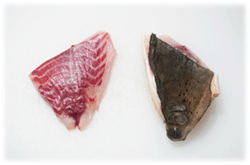 |
 |
| 1,The tail of the upper body which has been skinned and the tail of the lower body which has been seared. | 6,Cut the seared tail into sushi pieces. |
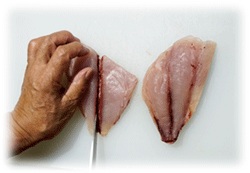 |
 |
| 2,Divide the skinned tail side part into belly body and back body. | 7,Use your hands to remove the skin from the back meat that will be used as sashimi, and make it into sear. |
 |
 |
| 3,Divide the seared tail part into dorsal and abdominal parts. | 8,Make hiratsukuri sashimi from the skinless back body part. |
 |
 |
| 4,The two on the left are the belly parts, and the two on the right are the back parts. | 9,The hiratsukuri sashimi are intentionally arranged in a curved shape. |
 |
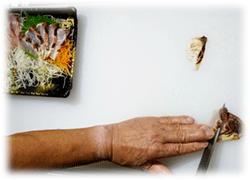 |
| 5,Cut the skinless tail part into sushi pieces. | 10,Cut the seared skinless back meat into usutsukuri sashimi and arrange it in a curved shape. |
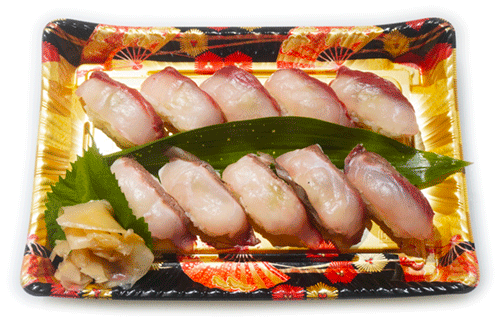 |
|
Scalpel sawtail nigiri sushi The top row is skinless and the bottom row is seared with the skin on. The skin of the seared sushi dane with skin is slender and comes off from the meat, so the skin is almost invisible. |
|
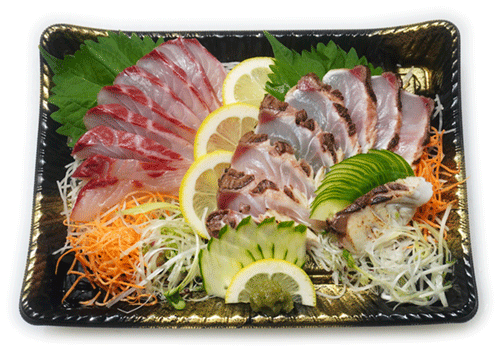 |
|
Scalpel sawtail sashimi On the left is skinless hiratsukuri sashimi. On the right is skinless seared thin sashimi. |
|
Thus, the scalpel sawtail sashimi and sushi were completed. As a result of tasting them, my impression was that even though they were seared, the unique smell still remained a little, and it was true that the smell could not be completely eliminated. If I were to rank the unpleasant smells, the strongest was Hiratsukuri sashimi, followed by seared usutsukuri sashimi. However, when it came to the nigiri sushi, both seared and unseared, the smell was weak and I felt it was the most delicious. This was probably because it went well with the sushi rice.
Scalpel sawtail cuisine
As mentioned above, in the preparation stage before cooking the scalpel sawtail, the skin of both fillets was seared. I thought that the savory smell of the roasted skin would offset the unique smell of the scalpel sawtail. This was just a prediction in my head, and I didn't know how it would turn out until I tried it.
It is possible to cook scalpel sawtail in a variety of ways, such as boiled fish, grilled with salt, or meunière, but with an experimental aim to make it more delicious, I decided to make one dish simply called "deep-fried fish" seasoned with only salt and pepper, and the second dish called "fried fish" with some seasoning. In this way, I decided to compare the taste of the dish using the common method of "cooking with oil."
In the following work process, the left column is deep-fried fish and the right column is fried fish.
| Cooking the scalpel sawtail with oil | ||
|---|---|---|
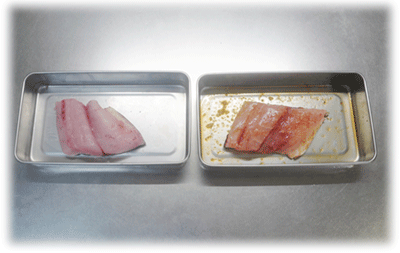 |
||
| 1,Sprinkle only salt and pepper on the fillet on the left, and add grated ginger, grated garlic, and an appropriate amount of soy sauce to the fillet on the right. | ||
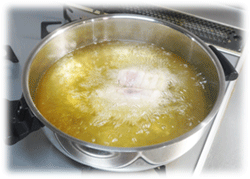 |
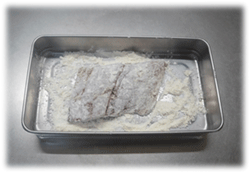 |
|
| 2,Place the fillets in hot oil at 180°C. | Dust fillets in flour. | |
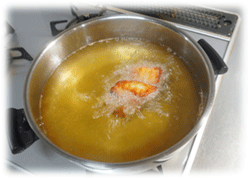 |
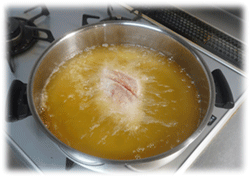 |
|
| 3,Fry for about 3 minutes. | 3,Fry at 170℃ for about 3 minutes. | |
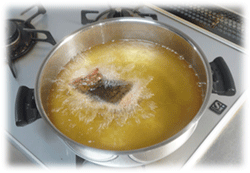 |
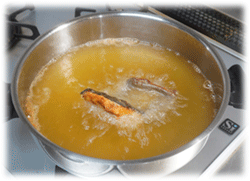 |
|
| 4,Flip the fillets and fry for 1 minute. | 4,Flip the fillets and fry for 1 minute. | |
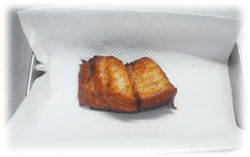 |
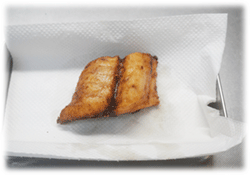 |
|
| 5,Drain off the oil. | 5,Drain off the oil. | |
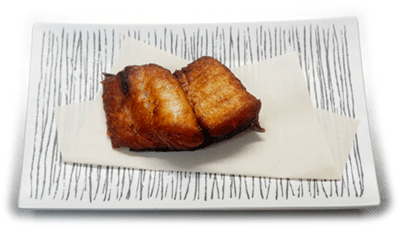 |
||
| Scalpel sawtail deep-fried fish | ||
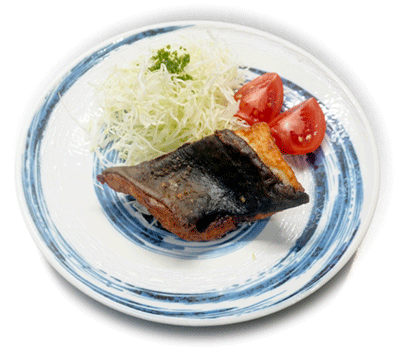 |
||
| Scalpel sawtail fried fish | ||
Thus, I created deep-fried and fried scalpel sawtail. I was thinking about how to make this unpopular fish tasty, and I tried to use the seared skin as a secret ingredient. So, what was the result of this experiment?
First of all, the deep-fried fish was fried in high-temperature oil, so the skin was crispy, which was a good way to utilize the skin itself. As for the meat, there was almost no particular smell and I didn't feel any particular problem. Since the meat was so thick, I thought it would be full of fat, but there was almost no fat in the meat and it had a light taste.
Next, the skin of the fried fish was not as delicious as the skin of deep-fried fish, probably because the oil was not at a high temperature, and the skin was not crispy and had a bad texture. However, the fried fish had some seasoning so it had more flavor than the deep-fried fish. Just like deep-fried fish, I can't feel the fat content, and since I can't take advantage of the flavor of the skin, the taste has less impact than deep-fried fish, and it ended up being half-hearted.
Utilization of unused fish
Now, when I tried cooking scalpel sawtail this way, I thought it was easy to understand why this fish is unpopular. However, the cost of raw materials for these four dishes is only about 100 yen per dish. Even if it were to become more expensive, it would still be within 200 yen at most.
Dear readers, if you were to put a selling price on these dishes mentioned above, how much would you set them? There are probably many other ways to get rid of the unique smell of scalpel sawtail, and there are many ways to come up with new ideas.
Not only the scalpel sawtail, but also other herbivorous fish species such as brassy chub, rabbitfish, and parrotfish seem to be thriving in the ocean, enjoying a position where they are not targeted by humans. If the marine ecosystem is reduced dramatically by only the fish that are caught as targets for humans, and the herbivorous fish species survive without fishing pressure, it seems that the marine ecosystem will change in an unnatural way.
Scalpel sawtail belongs to an unused fish species that is not actively harvested as a fishery resource at present, and it would be beneficial for the fisheries industry if people in the fisheries industry exercised their wisdom and made better use of it. In addition to the cabbage scalpel sawtail from Kura Sushi mentioned above, Aeon has started to manufacture and sell minced meat cutlets using stingray from Fukushima Prefecture. In fact, for over a year, the number of accesses to FISH FOOD TIMES July 2016 issue No. 151 Stingray Sashimi & Sushi has increased dramatically, and I wondered what was going on. Then, in June of this year, Aeon announced the stingrays they were selling, and I realized that it might be the influence of people related to Aeon.
The term "depletion of fisheries resources" has taken on a life of its own in the media, but this is a phenomenon limited to fish that are popular among the public. The media is not proactive in reporting on the fact that there are still many unused fish, such as scalpel sawtails and stingrays, that are not being fully utilized as fishery resources.
This month's article is about scalpel sawtail, one of the underutilized fish that are unpopular among fish retailers, but I wonder what readers who have read this far have taken away from the content of this article. Of course, I don't think I have presented a sufficient solution, but I think I have been able to dig deeper than in the article 15 years ago, and I would like to think that I have been able to provide some hints.
For those who are in the business of fish, I think that one of the real pleasures of business is to focus on minor fish that are not attracting attention, rather than chasing only the generally popular fish. It is.
| Please access the following URL if you want to secure using SSL. All pages in the site will be secure pages. |
https://secure02.blue.shared-server.net/www.fish-food.co.jp/message english 9.2024.html |
An opinion and the communication are to iinfo@fish food times
Date of updating 1 Sep. 2024
